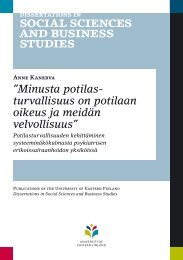urn_isbn_978-952-61-1770-6
urn_isbn_978-952-61-1770-6
urn_isbn_978-952-61-1770-6
- No tags were found...
Create successful ePaper yourself
Turn your PDF publications into a flip-book with our unique Google optimized e-Paper software.
2 The Current Story ofLegitimacy2.1 REASONS FOR LEGITIMACY QUESTIONS: THE ECtHR’SMETHODS OF INTERPRETATION AND ARGUMENTATIONThe ECtHR has been criticised by many on account of its increasingly far-reachinginterpretations of Convention provisions. Some of these criticisms relate toissues of state sovereignty and moral or cultural sensitivities at the national level.The Convention system has also been criticised on the basis of the institutionalaspects of the ECtHR. 62 This study, however, focuses on criticism to which theECtHR can itself react, in terms of the interpretation and argumentation used inits judgments. Institutional aspects, such as the amount of personnel and financialcapacity, are in the hands of others. This section outlines the scope of criticismdirected towards the ECtHR’s methods of interpretation and argumentation,which are linked to discussion of its legitimacy. Consequently, current discussionof judicial legitimacy is introduced and discussed in relation to the ECtHR.The main methods of interpretation used in relation to the ConventionContinental methods of interpretation are rather well-developed. The most wellknownand frequently used methods are as follows: grammatical/literal, 63 historical,systematic, genetic, teleological, and interpretation based on analogy or a contrario.If a judge refers to the meaning of a term in everyday language or technicallanguage, she uses grammatical (or literal) interpretation. If the judge refers to thehistory of the legal rule, she uses historical interpretation. In systematic interpretation,the chosen interpretation is achieved by reference to the position of the legalrule in the legal system and its relation to other norms, goals and principles.Genetic interpretation occurs when the judge refers to the intention of the legislator.Teleological interpretation involves referring to the goal or purpose of the legalrule. Interpretation by analogy involves deciding that that a particular rule whichapplies to situation A also applies to situation B because it resembles situation A inrelevant respects. Using a contrario interpretation means that the judge decides thereverse, by holding that a certain rule does not apply to situation A, because it does62Even though criticism has been provoked, the general stance has, however, been to laud the importanceof the Convention and the bulk of the ECtHR’s decisions as of significant human rights value(see e.g. Williams 2013, at 1158).63Common law also recognises three traditional approaches to statutory interpretation: ‘literal rule’,‘golden rule’ and the ‘mischief rule’, see e.g. Zweigert – Kötz 1998, at 265–267; Cook et al. 2001.25




